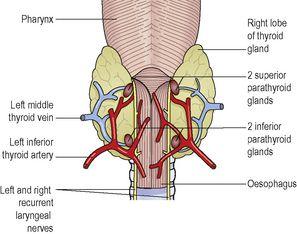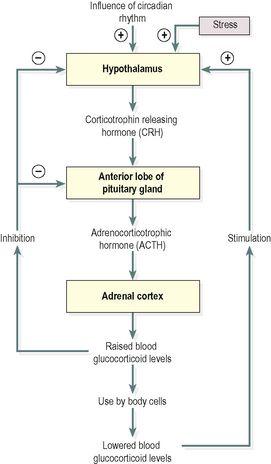Ross & Wilson Anatomy and Physiology in Health and Illness (99 page)
Read Ross & Wilson Anatomy and Physiology in Health and Illness Online
Authors: Anne Waugh,Allison Grant
Tags: #Medical, #Nursing, #General, #Anatomy

There are four small parathyroid glands, two embedded in the posterior surface of each lobe of the thyroid gland (
Fig. 9.9
). They are surrounded by fine connective tissue capsules. The cells forming the glands are spherical in shape and are arranged in columns with sinusoids containing blood between them.
Figure 9.9
The positions of the parathyroid glands and their related structures, viewed from behind.
Function
The parathyroid glands secrete
parathyroid hormone
(PTH, parathormone). Secretion is regulated by blood calcium levels. When they fall, secretion of PTH is increased and vice versa.
The main function of PTH is to increase the blood calcium level when it is low. This is achieved by indirectly increasing the amount of calcium absorbed from the small intestine and reabsorbed from the renal tubules. If these sources provide inadequate supplies then PTH stimulates osteoclasts (bone-destroying cells) and calcium is released from bones into the blood.
Parathormone and calcitonin from the thyroid gland act in a complementary manner to maintain blood calcium levels within the normal range. This is needed for:
•
muscle contraction
•
nerve transmission
•
blood clotting
•
normal action of many enzymes.
Adrenal glands
Learning outcomes
After studying this section you should be able to:
describe the structure of the adrenal glands
describe the actions of each of the three groups of adrenocorticoid hormones
explain how blood levels of glucocorticoids are regulated
describe the actions of adrenaline (epinephrine) and noradrenaline (norepinephrine)
outline how the adrenal glands respond to stress.
The two adrenal (suprarenal) glands are situated on the upper pole of each kidney (
Fig. 9.1
) enclosed within the renal fascia. They are about 4 cm long and 3 cm thick.
The
arterial blood supply
to the glands is by branches from the abdominal aorta and renal arteries.
The
venous return
is by suprarenal veins. The right gland drains into the inferior vena cava and the left into the left renal vein.
The glands are composed of two parts which have different structures and functions. The outer part is the
cortex
and the inner part the
medulla
. The adrenal cortex is essential to life but the medulla is not.
Adrenal cortex
The adrenal cortex produces three groups of steroid hormones from cholesterol. They are collectively called
adrenocorticocoids
(corticosteroids). They are:
•
glucocorticoids
•
mineralocorticoids
•
sex hormones (androgens).
The hormones in each group have different characteristic actions but due to their structural similarity their actions may overlap.
Glucocorticoids
Cortisol
(hydrocortisone) is the main glucocorticoid but small amounts of
corticosterone
and
cortisone
are also produced. They are essential for life, regulating metabolism and responses to stress. Secretion is controlled through a negative feedback system involving the hypothalamus and anterior pituitary. It is stimulated by ACTH from the anterior pituitary and by stress (
Fig. 9.10
). In normal conditions, secretion shows marked circadian variations. The highest level of hormone secretion occurs between 4 a.m. and 8 a.m., and the lowest between midnight and 3 a.m. When the sleeping and waking pattern is changed it takes several days for adjustment of the ACTH/cortisol secretion to take place (see
p. 211
).
Figure 9.10
Negative feedback regulation of glucocorticoid secretion.
Glucocorticoids have widespread metabolic effects generally concerned with catabolism (breakdown) of protein and fat that makes glucose and other substances available for use. These include:
•
gluconeogenesis
(formation of new sugar from, for example, protein) and hyperglycaemia (raised blood glucose levels)
•
lipolysis
(breakdown of triglycerides into fatty acids and glycerol for energy production)
•
stimulating breakdown of protein, releasing amino acids, which can be used for synthesis of other proteins, e.g. enzymes, or for energy (ATP) production (
p. 24
)
•
promoting absorption of sodium and water from renal tubules (a weak mineralocorticoid effect).
In pathological and pharmacological quantities glucocorticoids (commonly referred to as ‘steroids’) also have other effects including:
•
anti-inflammatory actions
•
suppression of immune responses
•
delayed wound healing.
Mineralocorticoids (aldosterone)
Aldosterone is the main mineralocorticoid. Its functions are associated with the maintenance of water and electrolyte balance in the body. Through a negative feedback system it stimulates the reabsorption of sodium (Na
+
) by the renal tubules and excretion of potassium (K
+
) in the urine. Sodium reabsorption is also accompanied by retention of water and therefore aldosterone is involved in the regulation of blood volume and blood pressure too.



